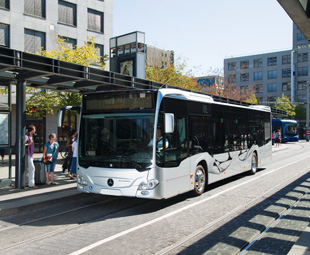Dealing with DORA

Current legislation is making it impossible for bus operators to ensure the profitability and survival of their businesses. But how bad is the situation, exactly?
As you may have already read in our brief overview of the Southern African Bus Operators Association (Saboa) national conference, the South African bus industry is at serious risk of collapse owing to underfunding.
“Funding for public transport is a worldwide phenomenon,” says Eric Cornelius, executive manager for Saboa. “In South Africa there is an even greater need for funding public transport, owing to the past policies, where people were placed far from employment opportunities. Long commuting distances are common in South Africa and this makes it expensive for commuters to travel. It is for this reason that government subsidises fares, so that it is more affordable for commuters.”
However, it was made abundantly clear at the association’s conference that the current state of affairs is anything but ideal.
According to the Department of Transport, as detailed in the presentation by Jackie Walters, strategic advisor to Saboa, the total available funds for public transport in the 2012/13 year was just over R12,7 billion. This included about R1,2 billion for scholar subsidies and just over R7,6 billion for municipal bus subsidies. In addition, highlights Walters, funds are also dedicated to the Gautrain and its bus feeder system, as well as to the various bus rapid transit (BRT) systems.
When all is said and done, about R37 billion is earmarked for public transport in South Africa. Walters notes that, if the Passenger Rail Association of South Africa (Prasa) subsidy is included, this figure moves closer to R40 billion.
 “Subsidies, on average, represent between 40 and 50 percent of an operator’s revenue, depending on the distances travelled,” explains Cornelius. “To be able to continue operating without subsidies, operators will have to increase passenger fares substantially. This, in turn, will make it unaffordable for commuters to travel by bus. It is, therefore, commuters who would be the worst affected if operators had no subsidies.”
“Subsidies, on average, represent between 40 and 50 percent of an operator’s revenue, depending on the distances travelled,” explains Cornelius. “To be able to continue operating without subsidies, operators will have to increase passenger fares substantially. This, in turn, will make it unaffordable for commuters to travel by bus. It is, therefore, commuters who would be the worst affected if operators had no subsidies.”
To put this all into perspective, during the 2012/13 year, 343,8 million passengers (or 6,8 million vehicle trips) were essentially subsidised, while 12,9 million passengers were unsubsidised. Plainly, the livelihood of many people would be affected by the high increase in fares.
Where then, does the problem lie? It would seem that a good starting point would be the Division of Revenue Act (DORA) of 2009, that determines how national government funding for bus contracts is allocated (called the Public Transport Operational Grant – PTOG). According to Walters, DORA is negatively impacting on all services.
However, according to Thys Heyns, corporate director at Larimar Group (representing Putco at the conference), the problem is not so much DORA itself, but how it is applied. “Owing to funding limitations, commuter bus operators do not receive the contractual increase in bus subsidies to keep pace with the cost increases in volatile cost items, such as fuel, labour and vehicle maintenance,” he says.
“DORA allocations to the PTOG are not based on contractual commitments or cost increases experienced by operators, but is an arbitrary number determined by National Treasury,” he continues. It is then up to the provinces to make up the shortfall. The provinces, however, do not have the necessary budget.
This shortfall is eye-opening. Since 2009, the total need for funding averaged 7,14 percent per year, while operators received an average of only 2,52 percent. To hammer his point home, a revenue model constructed by Heyns (for a typical bus company over the five years since DORA was initiated), shows that revenue of a typical commuter bus company increased by 30 percent, while expenditure increased by 50 percent. With profits steadily decreasing over the years, this led to operating losses in years four and five of -0,74 and -5,62 percent, respectively.
“While expenditure keeps increasing at a faster rate than revenue, all bus companies will fail,” says Heyns. “Some may fail sooner, some may fail later, but no company can survive this unsustainable business model in the medium and long term.”
It’s clear something needs to be done, but what? Cornelius highlights some drivers of growth that the industry needs. These include increased economic growth and increased employment, as well as the removal of the restrictions on contract operators so they can expand their services.
“A moratorium on expansions has been prevalent in the industry since 2001,” he says. “This, together with the DORA restrictions on funding, has hampered growth in the industry.” He also advises recapitalisation of the generally old vehicles run by small, medium and micro enterprises to drive growth in the industry.
Heyns suggests that if the subsidy escalations were paid according to the interim contract escalation formula (widely accepted in government bus contracts throughout the world), over the five years profits would have ranged from 8,46 percent to 17,85 percent. Nevertheless, he suggests that cutting costs even further, rationalising services, increasing fares, growing services and improving efficiencies are not achievable nor viable.
“The current bus contract system has effectively put bus operators in a straight-jacket and has removed the usual ‘levers of action’ available to business executives to ensure the growth or survival of their businesses and protect profit margins,” he exclaims.
Published by
Focus on Transport
focusmagsa



 !
From 1 Apri
!
From 1 Apri

 Big news from FOCUS on Transport + Logist
Big news from FOCUS on Transport + Logist





 FUSO: Driving the Future of Mobile Healthc
FUSO: Driving the Future of Mobile Healthc



 A brand
A brand




 Wondering about the maximum legal load for a
Wondering about the maximum legal load for a 
 The MAN hTGX powered by a hydrogen combus
The MAN hTGX powered by a hydrogen combus

 Exciting News for South African Operators
Exciting News for South African Operators

